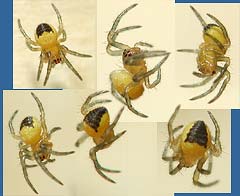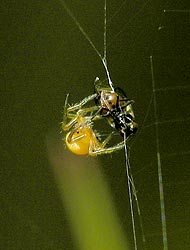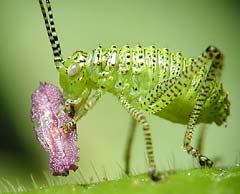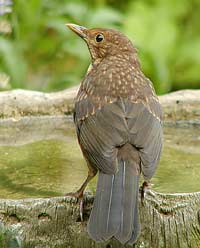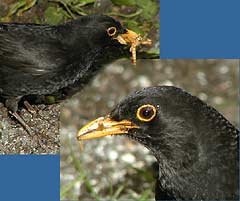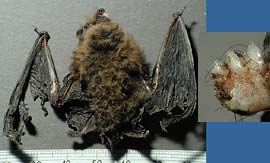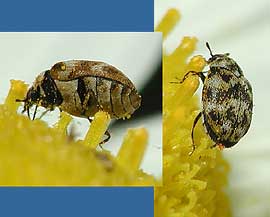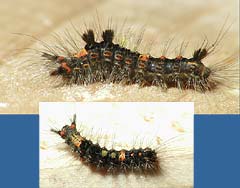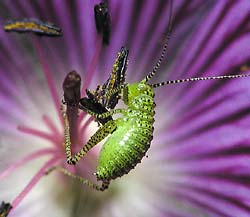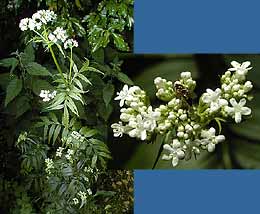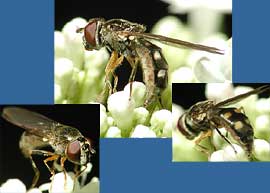Go to latest entry.....................................Go to previous entry
In these conditions the dandelion seed heads take on a very different appearance to the image I recorded at the beginning of the month - a bit more of a design for a hat made of feathers!
The heavy rain kept most birds under shelter and the Hawthorn was quite a busy place, and quite noisy, thanks to the sparrows. This Blue Tit would make occasional dashes out to the either the mealworm, sunflower feeders or down to the ground under the tree.
While I sat (under shelter) on our deck, this Dunnock made several visits to pick up bits of chopped peanut from under the Hawthorn. It seems to have an injury on its right side, although this does not seem to be hindering the Dunnock in any way. I wonder if this has resulted from an encounter with a Robin?
Talking of which, here is a Robin that was collecting mealworms for an offspring that occasionally made an appearance, but which I did not capture with the camera.
Looking as though it was waiting for the Oxeye Daisy to open (still only one open so far), this bee stayed in this position, swaying in a gusty breeze, for over half an hour before the sun came out and warmed it up.
We are getting to see sights like this more often now as fledgling Sparrows follow their mum to beg for food, crouching and vibrating their wings as they do so. A sibling of this one was waiting its turn on a Hawthorn branch. It's noticeable that the adult sparrows are less interested in the mealworm feeder now, with Blue Tits now the main visitors again. A Jay came to the garden twice during the morning, only to be chased away by the Blackbird, with sparrows in support. During the afternoon I saw it again, 'up the street' being chased by a Collared Dove this time.
A check of the Geranium plants revealed six of the Green Bush Crickets. While the rest were spread out,these two were perched on the tip of a White Dead-Nettle leaf, the plant growning in the midst of the geraniums.
The cool, showery weather is not encouraging a great deal of insect activity in the garden, with Bumble Bees being the most obvious visitors. I'm curious about one orange coloured bee that has a clearly striped abdomen ( no picture yet) and which frequents the White Dead-Nettles. I need to spend time by the nettles ready to ambush it (or them) with my camera. On a number of occasions I have seen it leave the flowers and head down into a small patch of thick undergrowth at one end of the big pond, disappearing from sight.
In the morning sunshine the main activity amongst the flies seemed to be sunbathing. This Greenbottle-like fly (it may be Orthellia cornicina) really showed off its metallic green exterior as it rested on an Oxeye Daisy.
Much smaller, and with a similar metallic green colour, coupled with huge red eyes, this little fly (is it a hoverfly?) was also enjoying the sunshine.
There were a few hoverflies venturing out this morning, including this one (Episyrphus balteatus - I think) resting briefly on a leaf of a Red Campion plant.
Another sunbather was this greyish coloured fly, about 1cm long.
The visible spider population seems to consist of very small, immature individuals, with a lot of fly-catching to do as they grow up through the summer. This one has just undergone a moult and is waiting for its new exoskeleton to harden as it rests below it shed skin.
I caught another glimpse of the Jay again as it was being chased across the garden by a male Blackbird. Later in the day the Blackbird was busy taking mealworms by the beakful to somewhere behind our Leylandii trees.
23 May - It has been a mainly dry, cool and breezy day, and sunshine was in short supply until late in the afternoon. The cool weather certainly seems to be having a negative effect on insect activity. I'm seeing few Bumble Bees and all solitary bee activity has stopped at the bee hotel. It may be a coincidence, but one insect notable for its absence is the small red-eyed fly that appears to lay its eggs in the nests of these bees. It was very active last year, but I haven't seen a single specimen so far this year.
Its strikingly dark colouring with a near-white border around its body marks it out as a male Philodromus dispar. It's name comes from the fact that the two sexes look very different (a disparity in appearance), with the female being pale brown with lighter patterns. The male in the photograph has a body length of just under 5mm. It is widespread in the UK. It is a spider that prefers to ambush prey and can change position very rapidly. Very sensitive to my movement, it quickly moved to hide behind the leaf just after the image was captured. Around the bases of leaf stalks seems to be a popular daytime hiding place for small spiders, such as this one on a Stinging Nettle. It measured about 5mm long. I haven't have been able to identify it, although it looks like one of the nocturnal hunter spiders. The nettle flowers are just starting to 'open' now.
Back on the Geranium, I spotted this little weevil which measures about 4mm in length. I have not yet identified it - my guides say that there are over 500 weevil species in the UK, but they only illustrate a handful of them.
This little Blue Tit seemed very happy to make many return visits to this piece of wholemeal bread (soaked with water), taking away lots of bits, presumably to feed young somewhere north-west of us. It did this despite mealworms being available in the feeder. A close look at the larger version of the image reveals a bare patch on its head. I don't know if this is an injury or just wet feathers. A pair of Starlings were also repeat visitors, taking beakfuls of the bread back to their nest when there were no mealworms available. The Blackbird continues to prefer mealworms.
A couple of days ago I photographed the young Sparrow being fed. Since then I have not seen any other moments like that and it adds to my concern about how successful breeding is being for them this Spring.
24 May - During a morning of some sunshine, mixed with threatening clouds, I have seen the first Starling fledgling, noisily pestering its parents for food in the garden. While the Crickets continue to thrive on the 'sunny side' of the Geraniums, there is action going on beneath the shelter of the leaves. Here, one of those orange coloured flies that settle on the Geraniums (and the Stinging Nettles) at night has been caught by one of the small spiders. I think the spider is a member of the Theridion genus - it measures no more than about 4mm in length.
The late afternoon saw a bit of passion on an Elder leaf when these mating Owl Midges were spotted. Each midge is about 4mm long. Tonight there was a solitary hedgehog in the garden, the first I've seen since the courtship sessions earlier in the month.
This one was about 4-5mm long and boldly coloured, with an orange head and an abdomen which was mostly yellow in colour. My guide books have failed me on its identification. This happens too often - I need to look into getting more detailed guides.
A more familiar visitor made its first appearance of the year this afternoon. It is a Hawthorn Shield Bug (Acanthosoma haemorrhoidale), and as soon as this picture had been taken (on an Iris leaf) it flew up into the Hawthorn tree.
Honey bees are, sadly, uncommon visitors to the garden these days. This is, I think, a Honey Bee worker, photographed as it paused on a Red Campion leaf before continuing on its pollen collecting way.
A slightly warmer day certainly had an effect on insect activity in the garden. There were more Bumble Bees about and a number of hoverflies were seen and, as this picture shows, there was solitary bee activity at the bee hotel for the first time for at least a week.
Likewise, larger moths have been in short supply, although I have been seeing micro-moths over the last few days. This one (not identified yet) was photographed as it fed on the nectar of the Oxeye Daisy this morning. It measures about 8mm from front of head to back of wings, and in the larger image you can see its extended proboscis.
Finally (probably), The first of the Wood Avens (Geum urbanum) flowered today, six days later than last year. Here it's pictured against the pink of the red campions. Usually a small, neat flower with five petals alternating with five sepals, this one has an extra petal. I shall have to note the other flowers as they open on this plant to see if they are the same.
It measures 9-10mm in length and has a light band of hairs at the rear end of each abdominal segment. The lower picture shows one wing partly opened out and showing its pattern of veins (venation). This helps in the narrowing down of the identification. Together with the stripes, this pattern suggests that it could be Colletes succinctus (or similar), a solitary bee that nests in sandy ground.
Late this afternoon, a look at the Birch tree was rewarded by the sight of three bundles of newly hatched spiders. Each group measured between 8-10mm across and all three were within 7cm of each other, and securely anchored to the bark by many silk threads. Interestingly there were several spiders of a different species on this same web. The left hand photograph shows one of them. Its body is less than 1mm long, compared to those in the bundles, at about 1.5mm in length.
Measuring just over 1cm long I think it is either Drassodes lapidosus or Drassodes cupreus. These are fierce nocturnal hunting spiders and their prey can include other spiders. In the daytime they hide away in silk retreats.
Since yesterday the three balls of spiders have moved and the spiders are just starting to spread out on a mass of silk threads, giving me a better opportunity to get some close-ups. These show them as perfectly formed miniature versions.
This spider, in a different part of the garden, but no bigger than the ones above is already engaged in the business of catching food. Here it is busy spinning a tiny fly around and wrapping it in silk. you can see the twisted threads above and below the fly, and if you look at the larger version of the picture you may see the silk thread just extruded from its spinnerets.
To give an idea of scale, the anther measures just under 3mm in length!
Opening the curtains brought me an encouraging start with the sight of this Blackbird fledgling, the first one seen this Spring. It seems that the attention of the Jay has not prevented at least one success so for for the Blackbird pair.
Even when there is no more room he continues to try, and several times he put the whole lot down so that he could try to pack them in more tightly. His action is quite understandable when you can hear Starlings, with their offspring very close by, and who will soon 'hoover up' what the Blackbird doesn't take straight away.
29 May - This has been a beautiful Summer's day, and I spent much of it at the top of a scaffolding tower replacing another part of our house's guttering. Most of the time I seemed to be accompanied by solitary bees which seemed to be looking for suitable holes for their nests. This morning, while I was getting ready to start work Sheila called me to see something on the ground. It turned out to be this dead bat.
It has a body length of about 40mm, a wingspan of marginally more than 180mm, with a forearm of 25-30mm (These measurements may not be accurate because of the state of the bat). It did not weich enough to register on our (suitably protected) electronic kitchen scales. I've looked at a couple of websites and the best match I can find is a Pipistrelle, which is a common species in towns. When my children were young we sometimes went down to the bottom of the garden around sunset to watch the bats 'patrolling' along the line of conifers, but I must confess that I haven't seem bats here for some years. I shall have to try wtching for them again. When the maintenance work on the outside of my house is completed I intend to make and put up some bat boxes.
Just one more photograph today - a tiny beetle(measuring about 3mm long) that seemed to be feeding on an Oxeye Daisy. The size and marking look right for a Varied Carpet Beetle (Anthrenus verbasci)
Hayfever has been a bit of a problem which didn't help with any photography, but I had to capture these images of a small caterpillar inside the lid of the mealworm feeder. It measures about 1cm in length and is very hairy. I cannot find a match in my caterpillar book, although it has similarities to a vapourer moth caterpillar.
On the bird front, there continues to be an almost complete absence of Sparrow fledglings. The Starlings continue to bring their offspring but it seems that we are only seeing a few family groups. There are a couple of Blue Tits taking food away and the Blackbird pair also continue to do so, with the female being seen almost as frequently as her partner. While Greenfinches are still staying away from the feeders, one could be seen and heard calling from the rooftop a number of times today.
31 May - Another very warm day, with the maximum temperature in the garden approaching 29C (although Farnborough airfield recorded 26C). I'll start with another mention of the caterpillar in yesterday's entry. It is still in the feeder tonight, despite many visits by Blue Tits, including a period when there were no mealworms left. I guess that the hairs and the bright spots act as warnings that the Blue Tits take notice of!
Just as in the last cricket photograph, this one is feasting on a geranium flower's anther(s). This time it was in the afternoon and it spent a couple of hours on the flower as it munched through the ripe anthers ( in the larger image you can see the pollen grains.
Last year I planted several Valarian (Valeriana officinalis) at the bottom of the garden. Unfortunately, we seem to have lost two of them. However, the one survivor is now over a metre high and came into flower today (nearly two weeks earlier than last year).
In the close view of the Valarian flowers you can see a hoverfly (I think) that landed as I was photographing the plant. I watched it for a few minutes as it moved between the flower buds. I could not see for sure, but is appeared to be laying eggs. At no time did I see any sign of it feeding. |
|
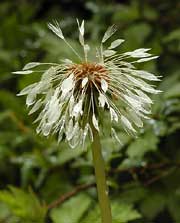

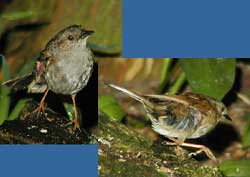
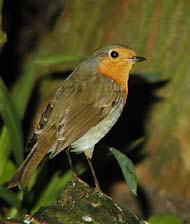
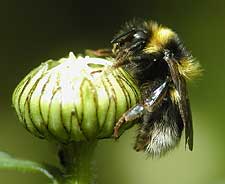
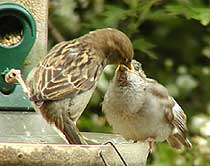
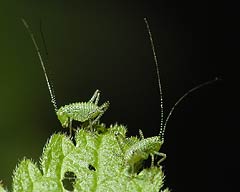
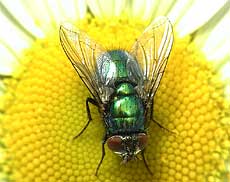
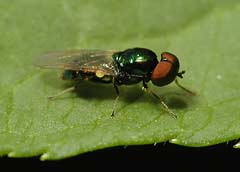
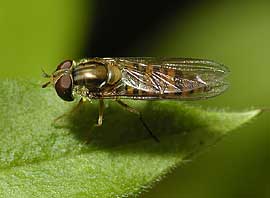
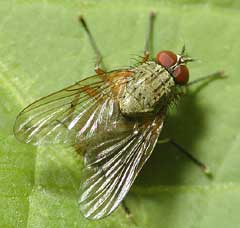
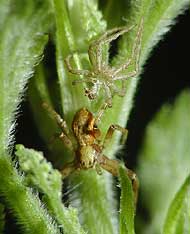
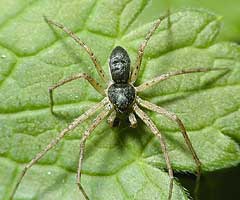
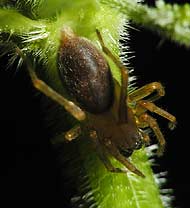
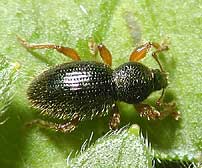
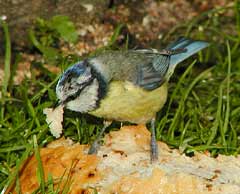
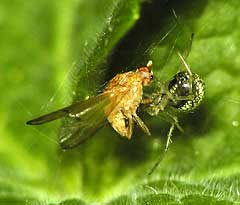
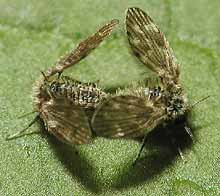
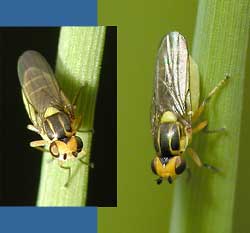
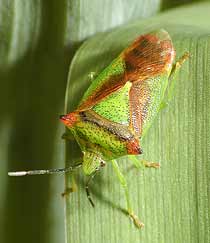
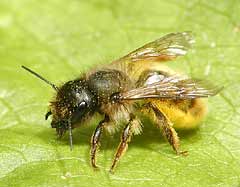
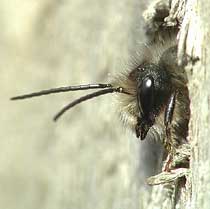
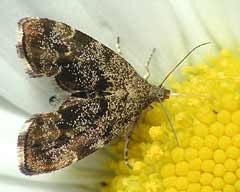
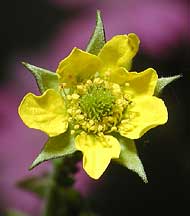
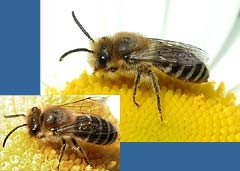
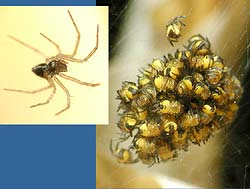
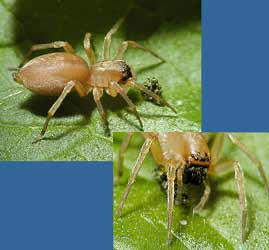 A
late look around the garden at 11.30pm revealed one black and
white cat (which disappered very quickly!) and this spider on
a geranium plant.
A
late look around the garden at 11.30pm revealed one black and
white cat (which disappered very quickly!) and this spider on
a geranium plant.